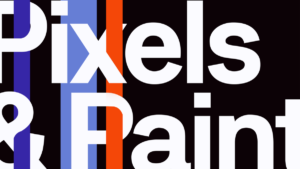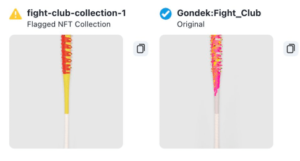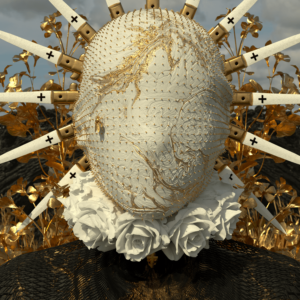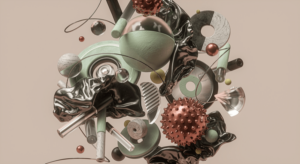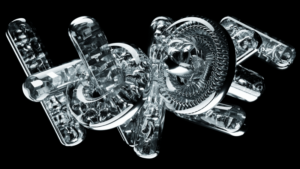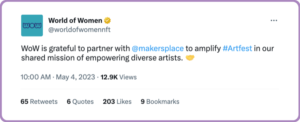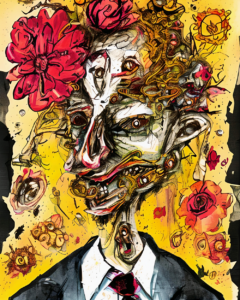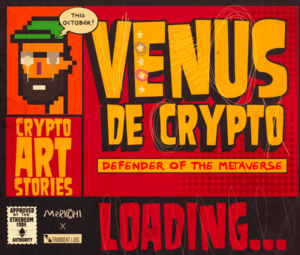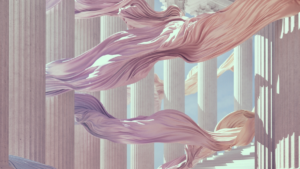Chazz Gold’s work seamlessly combines futuristic aesthetics with a strong sense of humanism and he has quickly emerged as a unique creative force. In this exclusive interview with Brady Walker of MakersPlace, Gold opens up about his inspirations, his experiences with AI, the traumatic brain injury that changed the course of his artistic output, and his aspirations for the future of art and technology.
So join us as we delve into the fascinating world of Chazz Gold – a world where technological innovation, artistic vision, and boundless creativity converge to form a truly unique and inspiring body of work.
Brady Walker: I’m most curious about the creative process for AI artists. Can you walk me through your creative process? For instance, how did you create “When Gods Face Off”? What was the seed of the idea, and how did you get to the finished piece?
Chazz Gold: For that piece, I actually used some of my own photography as initial images. I started off with a photograph or portrait that I’d taken with someone in the past. Lately, I’ve been doing photo shoots specifically for the purpose of turning them into AI art—lighting and composing them a certain way, shooting from different angles with different lighting, colors, and tones.
For “When Gods Face Off,” I used this website called Dreamlike.art, where about 95% of my AI art begins. I reached out to a couple of strong subjects that I knew and asked if I could use their images for this project, and they agreed. I generated a ton of images on Dreamlike.art, picked out the best ones, and then processed them at high resolution.
Next, I transferred the images to my iPad and used Motion Leap to add the elements I wanted. I created a 3D motion effect, where the subjects moved toward each other. I set up all six images in pairs, matching their tones and looks.
Once the animation was done, I sent it back to my iMac, put it in Final Cut, and then used Launchpad by Novation, a beat pad app, to create beats that matched the flow of the animation. As I watched the animation on the screen, I adjusted the beats accordingly. I sometimes created multiple versions or one long track and then picked out the best snippets to splice and piece together.
In the end, I combined everything and removed any unnecessary parts to create the final piece.
BW: What about the Sacred Cyborg series? How long did that whole series take?
CG: That one took a while; it’s actually kind of old in AI years. I created those back in October of last year. The Emiko piece will be on a billboard in Times Square on the 11th of April for an hour as part of a 200 artists billboard takeover event in NYC. It will also be featured on screens at the Javits Center, which I’m really proud of.
The series has a story behind it. It’s 13 years in the making. I had a traumatic brain injury back in 2009 and was in a coma for 12 days at a hospital in San Francisco. During my coma, I had this crazy dream that I was in a gallery looking at all these pieces of art on flat-screen TVs and computer screens at weird angles. The dream felt so real that after waking up, I visited the gallery, but they had no idea what I was talking about.
I used to paint, draw, and sketch, but I lost the use of my right hand due to the injury, so I couldn’t get those images out of my head. When AI came along, I took some of my pictures and fed them into AI, using a tool called Stable Diffusion on Dream Studios.ai. I wrote a long, detailed prompt and kept tweaking it until it was perfect.
I used an inpainting technique to mask in and out the parts I wanted, like the Grail on her neck and the crystals on her head. It took me about two or three months to finally get that one. When I saw it, I almost fell out of my chair, and it was 97% of what I saw in that dream. I continued generating more images with the same prompt, and I came up with the other three pieces that had the same tones and futuristic cyborg look.
In the long run, it’s a 13-year journey of creating a piece of art, and the Emiko piece is probably the most important one I’ve ever made because it pushed the boundaries of creation and a vision in a coma dream.
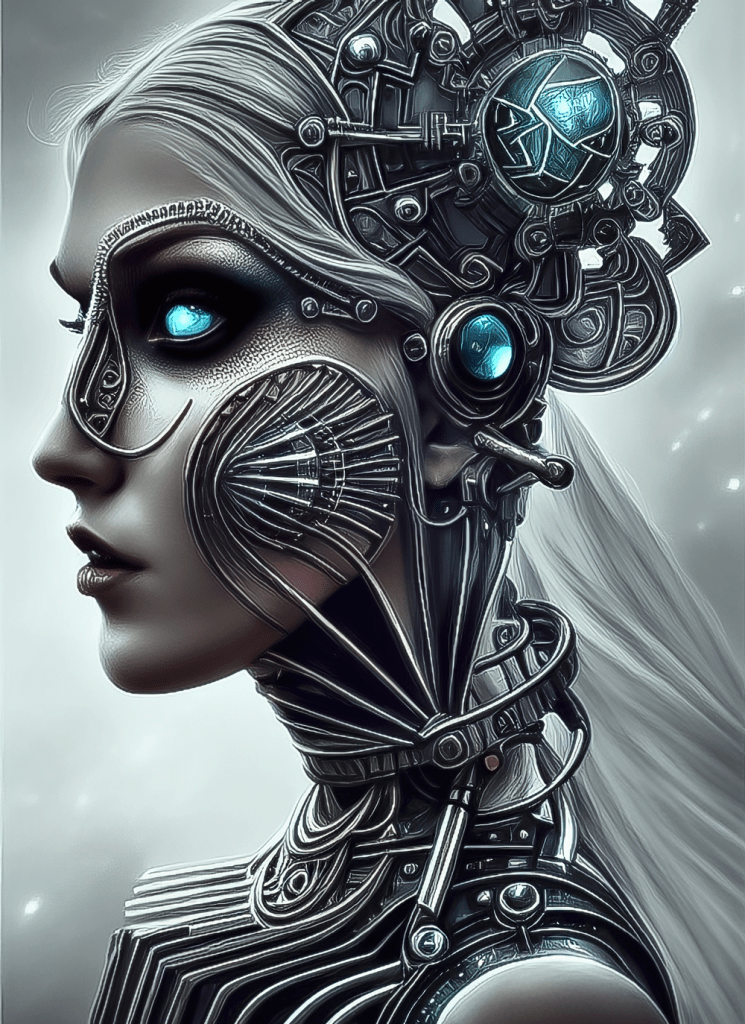
BW: How is the use of your hands now?
CG: Well, my hand function is still limited. I can use my index finger to hold down keyboard shortcuts, and I call my limited hand function “the claw.” I have a theory that after my injury, the synapses and receptors on the left side of my brain flooded the right side, making me extremely creative. My photography and other artistic pursuits took off after that, and it’s been building ever since. That’s my theory, anyway; it kind of makes sense to me.
BW: You were a photographer before the brain injury, but you were also involved in other art forms, right?
CG: Yes, I used to paint and draw using acrylics or oil paints. There was rarely a time when a sketchpad wasn’t within arm’s reach, along with pens, pencils, charcoal, and other artistic tools. My room was filled with stacks of journals and sketchpads, as I was always drawing, painting, or sketching.

BW: Your photography must have dramatically evolved after the brain injury, as it became the sole means of capturing your creative output. Can you tell us more about that?
CG: Yeah, after the injury, I did a lot of event photography, such as raves, nightclubs, and concerts, and stuck with that for a long time. I always did themed photo shoots with people, but it took me a while to get back into the compositional aspect of photography. Initially, I found it challenging to work with Photoshop with only one hand, but eventually, I figured out how to use keyboard shortcuts effectively.
I worked on a project called “The Shapes of the Divine” for about four years, which started as a gallery show in Portland and evolved into an idea for an augmented reality coffee table book. When I was trying to create this project, people seemed more interested in pixel art and didn’t pay much attention to photography in the NFT space.
Fortunately, now it seems that fine art and one-on-one art are gaining a foothold, and people are starting to pay attention to the artists. The collector base has grown, and there’s more appreciation for photography. I’m friends with other photographers, and we’ve all been trying to make our mark in the NFT world.
For me, the creative process is what matters. Whether my work sells or not, I’m going to keep doing it because it’s fun and empowering for both me and the people I photograph. The fact that my art is on the blockchain forever and serves as my legacy is payment enough for me.

BW: We’re planning to do a big push in the next two or three months to focus more on photography, similar to how we did for AI art and phygital. We want to put photography front and center.
CG: But we’re talking about real photography, not post-photography, right? Because there’s a difference.
BW: We’re having a bit of an existential moment trying to define photography.
CG: Yeah, what is photography? There’s real photography done with a camera, and then there’s post-photography, which is also great. As a photographer, I’m a little worried that post-photography will take a lot of jobs from photographers, because it’s easy to create realistic images with AI, especially with tools like Midjourney
My friend Binxs teases me about it, calling Midjourney “AI with training wheels.” He’s one of those people who codes everything himself, makes his own models, and trains them. We had a big discussion on Twitter the other day, and he argued that I was putting too much work into my prompts.
So I tried creating a shorter prompt and then added more details, weights, and variations until it became a 150-word prompt with weights. I showed him the progression on Discord, and he admitted that maybe the way I’m doing it is effective for me, even if he sees it as training wheels. I’ve been using ChatGPT to help me refine my prompts too.

BW: Do you want to share your process here, or is this a trade secret? Respect either way, so no pressure.
CG: Well, I start off with ChatGPT and use my old, messy prompts that work well for Stable Diffusion and Midjourney. I ask ChatGPT to rewrite the prompt for me, then I take that structure and rewrite it with different elements, colors, and palettes. I break down the elements so I can change them, and add my own prompts. I try to incorporate various art styles like neoclassicism, psychedelic art, or surrealism but avoid using specific artist names because I don’t want to steal anyone’s style.
Lately, I’ve been creating psychedelic art, but sometimes AI-generated art looks like other artists’ work, like Alex Grey. I have to be careful with what I submit to magazines or contests so it doesn’t seem like I’m copying someone else’s style.
After writing new prompts, I run them through ChatGPT again for proper punctuation and formatting. Then, I use AI tools like mid-journey, stable diffusion, and dreamlike to create the art. I have my own bot server on Discord to keep my prompts private because people can steal them.
When I create art, I start with mid-journey and then experiment with stable diffusion and dreamlike. Sometimes, I use the chaos mode in mid-journey, which adds a random factor to the art. It can create some wild and unexpected results. I’ve gotten some really crazy stuff out of it.

BW: How do you go about developing a personal style as an AI artist?
CG: My style is mainly focused on robotic, cybernetic goddesses, empowering women with futuristic themes. There was an artist and photographer, Factory 1019, who was active in the ’90s. He used to create these amazing compositions, photographing women and transforming them into cyborgs. He was one of my biggest influences early on, and I always wanted to create art like that with photography.
Before I got hurt, I was starting to explore that style. After recovering, it took me a while to get a camera and start working again. Now, with AI, I can combine my photography and the cyborg concept to create the art I’ve always wanted to do.
In terms of post-photography, there are a lot of old fashion books from the ’80s and ’90s by designers like John Paul Gaultier and Thierry Mugler. They were way ahead of their time. For instance, Gaultier designed the entire wardrobe for the post-apocalyptic movie, The Fifth Element. Both Gaultier and Mugler have been huge influences on my photography and set design.
BW: What was the second name?
CG: Thierry Mugler, who is known for the Angel for Men cologne. It’s my favorite cologne ever. Long before I knew about the cologne, he had a coffee table book called Fashion Fetish Fantasy, released in the late ’80s or early ’90s. As soon as I picked up that book, I was amazed. This was before Google, so I had to do a lot of research on fashion books and talk to people who knew about fashion to find out more.
I discovered that Mugler was his own photographer, lighting guy, and set designer. He even built his sets by hand and designed his own clothing. At 52 years old, he got a degree in biology to create his own perfumes and colognes. He’s like a superman of knowledge, a jack-of-all-trades, master of all.
I was so impressed by him, and he’s a big reason why I went back to school five years ago to get my degree in addiction counseling. I thought, if he could do it, I could do it. I once sent him a message on Facebook, thanking him for inspiring me and telling him I was going back to school for addiction studies. He actually responded, and we had a conversation for two days off and on. It’s pretty cool when your idols become real people.

BW: What do you hope to accomplish with your art, and what do you want viewers to take away from the experience?
CG: I want people to see my vision of what I would like the future to look like. If you could jack me into the matrix right now and turn me into a cyborg so I could live longer as part of the machine, I’d be all for it. I want people to see that the future doesn’t have to be bleak. There’s a lot of talk about climate change and the negative impact we have on the earth, but I draw inspiration from authors like William Gibson, Bruce Sterling, and Neal Stephenson, who wrote cyberpunk novels in the ’70s and ’80s, envisioning the future they wanted.
My art is a fusion of my favorite concept designers from the same era those books were written in, and I want it to represent what I’d like the world to look like a hundred years from now. I want people to see the beauty in the art, to hang it on their walls, and never get tired of looking at it. Sometimes I put my own art on a slideshow on my screen just to admire what I’ve created.
Working with AI isn’t always easy, and I’ve spent days refining prompts and going through thousands of images to get the one I want. I’m a disabled artist with limited hand function, and I want people to be inspired by the fact that I can still create despite all the challenges life has thrown at me. If I can inspire one person a day, then I’ve done my job.
BW: One last question, considering your love of technology and your passion for positive futurism: What types of technology are you looking forward to incorporating into your work, and what does the next year of experimentation and innovation look like for Chazz Gold?
CG: I’m excited about the idea of 3D models and integrating them with AI to create 3D art. I’d love to use the same prompts I’m using now to turn them into fully fleshed-out 3D models that can be printed or used as avatars. Imagine my art wrapped around an avatar’s body, where someone could buy it as an NFT and wear it in a virtual universe. I think that would be really neat, and it’s coming sooner than people realize.
The speed at which AI is advancing has been underestimated. Initial predictions suggested that AI would reach a certain point by 2037, but that timeline has been moved up to the end of this year. There are even discussions about putting a pause on AI development. I’m always trying to be on the cutting edge of the latest technology, but I’m still catching up in areas like coding.
BW: I’ll get GPT-4 to teach you how to code.
CG: That’s true. I’m really inspired by Claire Silver right now because she’s going above and beyond. Every time I turn around, she’s presenting something new to try. We used to sit in Clubhouse rooms at three in the morning, talking about AI and how it didn’t work for us, how we couldn’t get the images we wanted. We’d constantly change profile pictures every five minutes. Claire has come a long way, and I’m super proud of her. She’s a smart cookie and an inspiration, especially with her neurodivergent background.
There’s a lot of great art out there right now. I’ve noticed that the best of the best are rising to the top, while those who were just throwing out prompts and trying to make NFTs with simple images are starting to fade away. The cream is rising to the top, and it’s interesting to see the progression.
For updates on all of our upcoming artist spotlights, subscribe to our newsletter below.
- SEO Powered Content & PR Distribution. Get Amplified Today.
- PlatoAiStream. Web3 Data Intelligence. Knowledge Amplified. Access Here.
- Minting the Future w Adryenn Ashley. Access Here.
- Buy and Sell Shares in PRE-IPO Companies with PREIPO®. Access Here.
- Source: https://rare.makersplace.com/2023/04/24/interview-with-ai-artist-chazz-gold/?utm_source=rss&utm_medium=rss&utm_campaign=interview-with-ai-artist-chazz-gold
- :has
- :is
- :not
- :where
- $UP
- 1
- 12
- 13
- 200
- 3d
- 3D motion
- 9
- 95%
- a
- About
- about IT
- above
- accomplish
- accordingly
- active
- actually
- add
- added
- addiction
- Adds
- Adjusted
- admitted
- advancing
- After
- again
- ago
- ahead
- AI
- ai art
- alex
- All
- along
- also
- always
- amazing
- an
- and
- Angel
- animation
- any
- app
- appreciation
- April
- ARE
- areas
- around
- Art
- artist
- artistic
- Artists
- AS
- aspect
- At
- attention
- augmented
- Augmented Reality
- authors
- Avatars
- avoid
- away
- back
- background
- base
- BE
- Beauty
- became
- because
- become
- been
- before
- behind
- below
- BEST
- Beyond
- Big
- Biggest
- biology
- Bit
- blockchain
- body
- book
- Books
- Bot
- both
- boundaries
- Boundless
- Brain
- Break
- Bruce
- Building
- built
- but
- buy
- by
- call
- called
- calling
- came
- camera
- CAN
- Capturing
- careful
- Center
- certain
- Chair
- challenges
- challenging
- change
- changed
- Chaos
- ChatGPT
- Climate
- Climate change
- Clothing
- clubhouse
- code
- Coding
- Coffee
- collection
- collector
- Cologne
- Coma
- combine
- combined
- combines
- come
- coming
- computer
- concept
- concerts
- considering
- constantly
- continued
- converge
- Conversation
- cookie
- Cool
- copying
- could
- Couple
- course
- crazy
- Cream
- create
- created
- Creating
- creation
- Creative
- creativity
- curious
- Cut
- cutting
- cyberpunk
- cyborgs
- day
- Days
- Degree
- Design
- designed
- Designer
- designers
- Despite
- detailed
- details
- developing
- Development
- DID
- difference
- different
- Diffusion
- disabled
- discord
- discovered
- discussion
- discussions
- do
- does
- Doesn’t
- doing
- done
- Dont
- down
- dramatically
- draw
- drawing
- dream
- due
- during
- each
- Early
- earth
- easy
- Edge
- effect
- Effective
- effectively
- either
- element
- elements
- Else’s
- emerged
- empowering
- end
- enough
- Entire
- Era
- especially
- Ether (ETH)
- Even
- Event
- eventually
- EVER
- Every
- everything
- evolved
- excited
- Exclusive
- existential
- experience
- Experiences
- experiment
- explore
- extremely
- Face
- factor
- factory
- fade
- FANTASY
- fascinating
- Fashion
- Favorite
- featured
- Fed
- figured
- filled
- final
- Finally
- Find
- fine
- Fine Art
- finger
- flow
- Focus
- focused
- For
- Force
- forever
- form
- forms
- Forward
- found
- four
- Francisco
- friend
- friends
- from
- front
- fully
- fun
- function
- fusion
- future
- futuristic
- gaining
- Gallery
- generated
- generating
- get
- Go
- GODS
- going
- Gold
- Grail
- great
- grown
- Guy
- had
- hand
- Hands
- Hang
- Have
- having
- he
- head
- help
- her
- here
- High
- his
- hold
- hope
- Hospital
- hour
- How
- How To
- HTTPS
- huge
- hundred
- Hurt
- i
- I’LL
- idea
- if
- images
- imagine
- Impact
- important
- impressed
- in
- In other
- incorporate
- incorporating
- index
- initial
- initially
- Innovation
- Inspiration
- inspire
- inspired
- inspiring
- instance
- Integrating
- interested
- interesting
- Interview
- into
- involved
- iPad
- IT
- jack
- Job
- Jobs
- John
- join
- Join us
- journey
- just
- Keep
- Kind
- knowledge
- known
- Last
- Last Year
- Late
- latest
- Launchpad
- left
- Legacy
- Life
- Lighting
- like
- Limited
- little
- live
- Long
- long time
- longer
- Look
- look like
- looking
- LOOKS
- lost
- Lot
- love
- machine
- made
- magazines
- mailchimp
- mainly
- make
- MAKES
- Making
- mark
- mask
- master
- matched
- matching
- Matrix
- Matters
- max-width
- means
- Men
- message
- MidJourney
- minutes
- Mode
- models
- moment
- months
- more
- morning
- most
- motion
- movie
- much
- multiple
- must
- name
- names
- Neal Stephenson
- Neat
- negative
- never
- New
- Newsletter
- next
- NFT
- NFT space
- NFTs
- no
- now
- NYC
- october
- of
- off
- Oil
- Old
- on
- once
- ONE
- ones
- only
- opens
- or
- Other
- our
- out
- output
- own
- pad
- paint
- painting
- pairs
- part
- parts
- passion
- past
- Paul
- Pay
- payment
- pencils
- People
- perfect
- perfumes
- person
- personal
- photographer
- photography
- photoshop
- phygital
- picked
- Pictures
- piece
- pieces
- Pixel
- planning
- plato
- Plato AiStream
- Plato Data Intelligence
- PlatoAiCast
- PlatoData
- plugin
- Point
- Portland
- portrait
- positive
- Predictions
- pressure
- pretty
- private
- probably
- process
- Profile
- progression
- project
- proper
- proud
- purpose
- Push
- pushed
- put
- Putting
- question
- quickly
- random
- reach
- reached
- real
- realistic
- Reality
- realize
- really
- reason
- recovering
- refine
- refining
- released
- Removed
- represent
- research
- Resolution
- respect
- Results
- rising
- Room
- Rooms
- Run
- same
- San
- San Francisco
- School
- Screen
- screens
- seamlessly
- Second
- Secret
- see
- seed
- seem
- seemed
- seems
- sees
- Sells
- sense
- Series
- serves
- set
- Sets
- shapes
- Share
- shooting
- show
- side
- Silver
- similar
- Simple
- since
- SIX
- smart
- So
- some
- Someone
- something
- Soon
- Space
- specific
- specifically
- speed
- spent
- square
- stable
- Stacks
- start
- started
- Starting
- sterling
- Still
- Story
- strong
- structure
- studies
- studios
- style
- styles
- submit
- subscribe
- such
- Super
- Synapses
- table
- Take
- takeover
- Talk
- talking
- technological
- Technology
- tell
- terms
- than
- that
- The
- The Future
- The Gallery
- the world
- their
- Them
- Themed
- then
- There.
- These
- they
- think
- this
- this year
- those
- thought
- thousands
- three
- Through
- Throwing
- time
- timeline
- times
- tired
- to
- together
- Ton
- too
- took
- tool
- tools
- top
- toward
- track
- trade
- trade secret
- Training
- trains
- transferred
- transforming
- tried
- true
- truly
- TURN
- Turning
- tweaking
- two
- types
- Unexpected
- unique
- Universe
- until
- upcoming
- Updates
- us
- use
- used
- using
- various
- viewers
- Virtual
- vision
- visited
- want
- wanted
- was
- Way..
- we
- Web3
- Website
- WELL
- were
- What
- What is
- when
- whether
- which
- while
- WHO
- whole
- why
- Wild
- will
- William Gibson
- with
- within
- Women
- WordPress
- WordPress plugin
- Work
- worked
- working
- world
- worried
- would
- Wrapped
- writer
- writing
- written
- year
- years
- you
- Your

